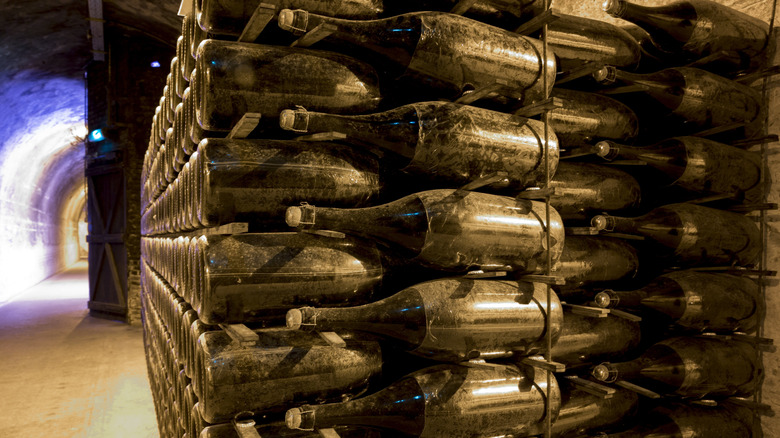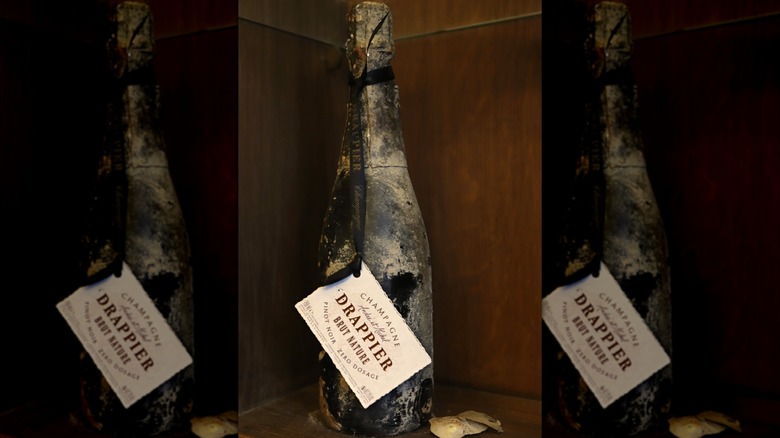Why The Baltic Sea Is A Graveyard For Champagne Bottles
The Baltic Sea is a treasure trove for shipwreck explorers. Not only are these treacherous waters a common final resting place for many boats lost at sea, but they're also home to some of the more well-preserved shipwrecks known today. In the wrecks, divers have found some pretty neat cargo, including thousands of bottles of Champagne. The sparkling wine aboard these ill-fated ships was likely on its way to places like Estonia, Latvia, Lithuania, and Russia, where it was a very popular drink among royalty. Carrying Champagne on this route was dangerous due to the shallow waters, thousands of small islands, and rough storms that afflict the Baltic Sea.
However, the first recovered ship full of Champagne actually sank after being shot by a German U-boat. In 1998, Swedish divers discovered the Jönköping, which sank in October 1916. The greatest treasure onboard? A whopping 3,000 bottles of 1907 Heidsieck & Co Monopole Goût Américan Champagne. Even after all that time under the sea, the wine was still drinkable, thanks to the Baltic Sea's cellar-like conditions. The sea is a dark and cold mix of freshwater and saltwater, and the low salinity and temperature aid preservation.
Writer Chris Hoel described the taste of the Jönköping treasure in an article for St. Louis Magazine. "Maybe it was the power of suggestion, but I could taste the sea, the explosion, and the Champagne all at once," Hoel said. He detected notes of "graham cracker, burnt lemon oil, and flamed oranges" as well as "caramelized bananas, burnt citrus, and kerosene."
More shipwrecked Champagnes
Researchers sampled some of the oldest Champagnes ever tasted after divers recovered 168 bottles of Juglar and Veuve Clicquot in 2010. The ship sank in the Baltic Sea sometime in the late 1840s, and the Champagne was bottled a decade or more before that. Findings published in Proceedings of the National Academy of Sciences showed that the bottles had initial notes of cheese, animal, and wet hair, but upon oxygenation, they evolved to "grilled, spicy, smoky, and leathery, together with fruity and floral notes."
Veuve Clicquot was so fascinated by the way the water had preserved the Champagne that in 2014, its winemakers submerged 350 bottles of Champagne in the same area of the Baltic Sea in an attempt to recreate the shipwrecked vintages. In 2023, Veuve Clicquot even offered an exclusive visit to sample the wines from the underwater experiment. Though specific notes varied widely across the different types of Champagne, "In general, the Champagnes aged in the cellar were more open, with broader fruits and more tertiary notes, while those aged in the Baltic Sea were a little shy and rather closed, with tighter fruit and more non-fruit flavors," wrote Yuri Shima for Club Oenologique. Some of the sea-aged wines had a notable vibrancy and comparatively more frothy mousse.
Veuve Clicquot isn't the only Champagne house to use the ocean to age its products. Leclerc Briant winemaker Hervé Jestin, who is well-known for making biodynamic wines, has an underwater cellar at close to 200 feet deep in the Atlantic Ocean. The deep-sea Champagnes, called Abyss, sell for around $200 a bottle.

